
Goosefishes are anglerfishes in the family Lophiidae found in the Arctic, Atlantic, Indian, and Pacific Oceans, where they live on sandy and muddy bottoms of the continental shelf and continental slope, to depths of more than 1,000 m (3,300 ft). Like most other anglerfishes, they have a very large head with a large mouth that bears long, sharp, recurved teeth. Also like other anglerfishes, the first spine of the spinous dorsal fin has been modified as an angling apparatus (illicium) that bears a bulb-like or fleshy lure (esca).

The Gempylidae are a family of perciform fishes commonly known as snake mackerels or escolars. The family includes about 25 species.

Pycnodus is an extinct genus of ray-finned fish from the Eocene period. It is wastebasket taxon, although many fossils from Jurassic or Cretaceous are assigned to this genus, only Eocene species, P. apodus is valid. As its name suggests, it is the type genus of Pycnodontiformes.

Urolophus is a genus of round rays mostly native to the western Pacific Ocean and the Indian Ocean, though one species occurs in the Pacific waters of the Mexican coast. Müller and Henle erected Urolophus in an 1837 issue of Bericht Akademie der Wissenschaften zu Berlin. The name is derived from the Greek oura, meaning "tail", and lophos, meaning "crest". In Urolophus, the outer rims of the nostrils are not enlarged into lobes, but may form a small knob at the back.
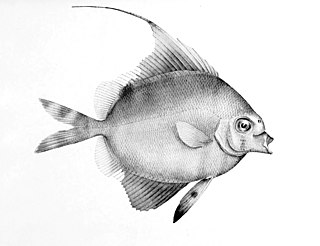
Sailfin moonfishes are a small family, Veliferidae, of lampriform fishes found in the Indian and western Pacific Oceans. Unlike other lampriforms, they live in shallow, coastal waters, of less than 100 m (330 ft) depth, rather than in the deep ocean. They are also much smaller than most of their relatives, up to 30 cm (12 in) in length, and have deep, rather than elongated, bodies. They are characterised by their ability to retract the anterior rays of their dorsal and anal fins into a sheath.
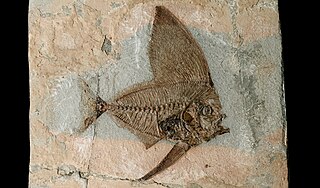
Exellia is a genus of extinct spadefish that lived in the Tethys Ocean during the early Paleogene. The adult form is shaped akin to a large spadefish or a short dolphinfish, with very large pelvic fins, and a long dorsal fin starting from in front of the eyes to near the base of the caudal peduncle. The juvenile form resembles a juvenile drumfish, with the dorsal fin forming a long crest on top of the head.

The popeye catalufa, also known as the bigeye soldierfish, is a species of marine ray-finned fish in the family Priacanthidae, the bigeyes. This fish has an overall dusky orange to red colour with white markings. The dorsal fin appears feathery while rest of fins have black margins. It occurs in the eastern Pacific, where it is found from Oregon to Chile. It occasionally makes its way into the aquarium trade. It grows to a size of 34 centimetres (13 in) in length. This species is nocturnal and shy, preferring deeper waters off islands. It has been recorded associating with squirrelfishes and cardinalfishes but the popeye catalufa goes as deep as 76 metres (249 ft), deeper than its associated species. This species has been recorded from rocky habitats at depths of less than 5 metres (16 ft) to over 100 metres (330 ft). It is a carnivorous species and, when kept in captivity, is known to feed on worms, crustaceans and brittle stars.
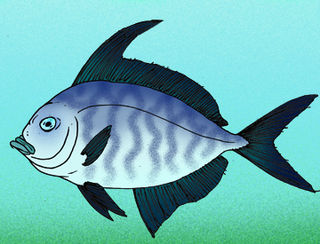
Veronavelifer sorbinii is an extinct sailfin moonfish from the Lutetian epoch of the Monte Bolca lagerstatten.
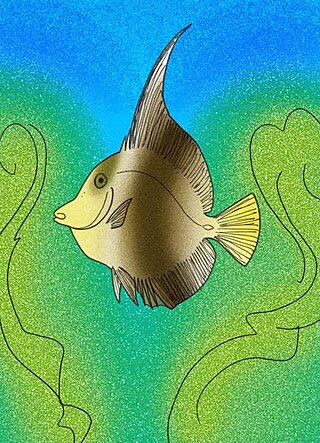
Eozanclus brevirostris is an extinct relative of the Moorish idol that lived during the late Ypresian epoch of the Eocene in what is now Monte Bolca, northern Italy. It differs from its living relative by having a much shorter snout.
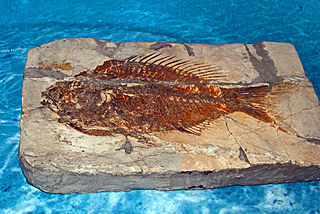
Sparnodus is an extinct genus of prehistoric perciform fish in the family Sparidae. Species of this genus were nektonic carnivore. These fishes lived in the Cenozoic Era, in Oligocene and Paleocene.
Palimphyes is an extinct genus of prehistoric euzaphlegid bony fish related to the escolars and snake mackerels. The various species lived as deepwater mesopelagic predators in the Tethys and Paratethys oceans, with fossils of ten species found in Paleocene to Oligocene strata of the Swiss Alps, the Carpathian and Caucasus Mountains, Iran, India, and Turkmenistan.
Caucasichthys is an extinct genus of perciform bony fish which existed in Russia during the middle Eocene epoch. It is known from the Gorny Luch locality of northern Caucasus. It was first named by Alexandre F. Bannikov, Giorgio Carnevale and N. V. Parin in 2011 and the type species is Caucasichthys kumaensis. The generic name comes from Caucas, from Caucasus and ichthys, fish. The specific name is derived from the Kuma Horizon, where the fossils were found.
Sharfia mirabilis is an extinct species of anglerfish in the family Lophiidae. It was discovered in 2011 during a review of fossil material at the Muséum national d'histoire naturelle in Paris. The fossil material was collected from the Monte Bolca Lagerstätte, one of the earliest known Eocene fossil sites. The undescribed genus was originally identified as Lophius brachysomus.
This list of fossil fish species is a list of taxa of fish that have been described during the year 2012. The list only includes taxa at the level of genus or species.

Pristigenys is a genus of marine ray-finned fish in the family Priacanthidae. It contains five extant species and one extinct species, P. substriata, which is known from fossils found in the Eocene of Monte Bolca, Italy.
This list of fossil fishes described in 2016 is a list of new taxa of jawless vertebrates, placoderms, acanthodians, fossil cartilaginous fishes, bony fishes and other fishes of every kind that have been described during the year 2016, as well as other significant discoveries and events related to paleontology of fishes that occurred in the year 2016. The list only includes taxa at the level of genus or species.

Lophius brachysomus is an extinct species of anglerfish in the family Lophiidae. It was described by Louis Agassiz in 1835 from the Monte Bolca locality. It became extinct during the middle Eocene.











